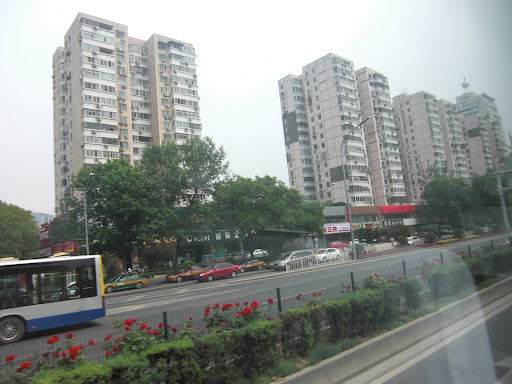The buildings fast forward in time as we drive into town from the Great Wall. Now there is a mix of residential and commercial buildings, yet, they all look similar. The buildings downtown are all high-rises, whether they are apartment complexes with A/C units hanging out windows or office buildings with glass sides. The buildings are rectangular and remind me of Lego blocks. Frankly I find these buildings to be ugly; the ugliest part being their repetitiveness. There seems to be a penchant for constructing the exact same building right next to one another. I find it a real eyesore to see three or four of the same buildings lined up. This in addition to the uniform height of all the buildings (due to height restrictions) make a for a disappointing skyline.


That is, until we drive by the China Central Television Headquarters building (CCTV). With its unconventional tee pee architecture and a facade with abstract criss-cross lines on it, the modern building really stands out amidst its unoriginal Lego block neighbors. Beijing locals call it the split legs building because that's what it looks like. It has two legs connected by a slim, horizontal portion of building. Between the legs is empty space. All the lines of the building are slanted, and there are no right angle intersections. Like a pair of walking legs, the building has a natural form that gives it a dynamic feel. The criss-cross lines on the facade are my favorite part because it looks as if some giant pounded his fist on top of the building and cracked it like an eggshell. I wonder how the criss-cross lines impact the layout of the windows though. Next to the split leg building is its simpler, accompanying building: a vertical structure that slowly widens at the base. When we had driven to a certain point our tour guide told us that from this view we could see where the inspiration for the split leg building came from. One can see from this angle how the two buildings complement one another, with split legs in the forefront and its partner running straight up through the middle behind it. Apparently the Dutch architects, Rem Koolhaas and Ole Scheeren, used the union of female and male as inspiration for the two buildings. Chinese officials were not aware of this inspiration until it was much too late, which became a bit of an embarrassment. Perhaps that's why all the new buildings being constructed around it are the same boring Lego ones. But I like to think that the CCTV building is a big middle finger to the sea of architectural conformity that surrounds it.

No comments:
Post a Comment